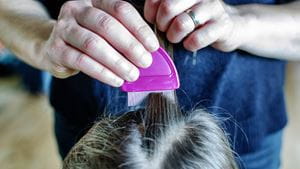
There is no getting around it: having to deal with lice feels gross. Most common among preschool and elementary school-aged children, lice are insects that live in human hair close to the scalp and feed on blood to stay alive.
If a child or adult is found to have head lice, it does not mean they have poor personal hygiene or live in an unclean home or school. They simply came in contact with another person who had lice.
We explain how to recognize lice, how to treat and get rid of them, and how to prevent yourself from becoming infested with lice.
While researchers and scientists know lice are estimated to have been around for millions of years, it is unclear where they originate. Approximately 6-12 million people living in the U.S. deal with a lice infestation each year, according to CDC estimates.
Lice are usually found in two stages: lice eggs (also called nits) and adult lice. Nits are yellow or brown and do not move. They are barely visible with the naked eye and take 8-9 days to hatch. Once a nit hatches, its egg becomes clear. Adult lice are about the size of a sesame seed and have special feet that allow it to hold tightly to human hair while crawling.
Most of the time lice will spread from person to person by direct hair-to-hair contact. It is less common to have lice travel from an object to a person’s hair because lice crawl; they do not jump or fly. However, it still worth taking the precaution of not sharing hats, scarves, combs, brushes, or other items that come into contact with another person’s hair.
If someone is asking, Do I have lice or am I paranoid?, it is helpful to know the signs of a lice infestation. These may include:
Lice is usually found by combing through a person’s hair to check for live adult lice. Some find them easier to distinguish from lint or dandruff when the hair is wet because nits and lice cling tightly to human hair and are difficult to remove.
Once lice is found in a person’s hair, it needs to be removed from the hair. This can be done by separating the hair into sections and using a fine-tooth comb to brush each nit or adult lice out. Friends and family who have had close contact with the affected person should do a lice check using a fine-tooth comb, as well.
Many head lice treatments are available without a prescription as over-the-counter (OTC) shampoos or creams. Following the directions exactly – recommended amount, time left in hair, using only one product, etc. – is key to getting rid of any nits and lice in the hair.
Once the shampoo or cream is applied according to directions, experts from the American Academy of Dermatology recommend checking the hair again 8-12 hours later to make sure any lice activity has slowed or stopped. Continue using the product(s) as directed until any signs of lice are gone.
If one or more people in a home still have lice after a few weeks, see a dermatologist for additional treatment guidance and recommendations. Medications can be helpful in eradicating any lice or nits – some include:
If lice treatment at home is not an option, there are several local services offering lice treatment and removal. Some will ask individuals or families to come in for treatment, while others come to people’s homes.
Lice do not carry any kind of disease, but protecting yourself and your family from an infestation is still important. This can be done in several different ways.
Avoid head-to-head contact: While at school, home or other places, try not to touch hair with others. This can be on the playground, at sporting events, sleepovers, and other activities.
Avoid sharing clothing or clothing items: Items that have had direct contact with a person’s hair may carry some lice. Things like hats, coats, team uniforms, hairbands, hair clips, headphones, brushes, or towels should be used only by a single person.
Soak/dry clean items: Temperatures above 130°F will kill lice. Soak combs, brushes, or other durable items in hot water at or above 130°F. Wash and dry bedding, towels, clothing, stuffed animals, or other items on the hottest setting in the dryer to kill any remaining nits or lice.
Do not use fumigants: Using a spray or fog to kill head lice is not necessary. If inhaled or absorbed through the skin, these can be toxic and cause more problems than lice.